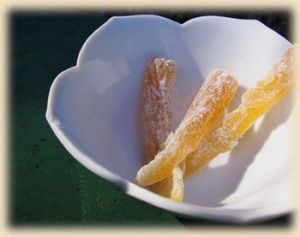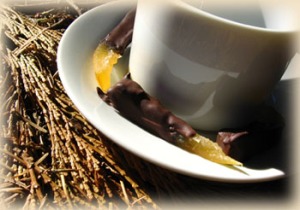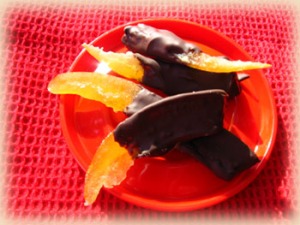
Sugar High Fridays is a monthly dessert blogging event created by Jennifer, the Domestic Goddess. Each month we get our sugar high on in keeping with a theme. This month, as the hostess of SHF #53, I chose “The Test of Time – Desserts over a century old” and bloggers from all corners of the sugar high world reached back through the ages with their spoons and mixing bowls, to grandparents and ancestors and beyond, to bring some time-tested sweet treats of yore onto our plates.
Join me now for a trip backwards through time, beginning with the recent past and nibbling our way all the way back to antiquity. And be sure to check out the individual posts for family memories, cooking adventures, old recipes in their original curious formats, and fascinating, well-researched culinary history!
Great Grandma Kelly’s Jam Cake
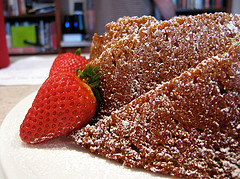
Laura of The Spiced Life recreates her grandmother’s great-grandmother’s jam cake, starting with figuring out how to actually make the cake! The long line of matriarchs passed down the ingredients through the years, but figured their descendants should be smart enough to figure out the rest of the directions. Luckily Laura was more than up to the challenge, as her moist, elegant creation attests!
140 years ago ~

Friedl of Kitchen Fun gets daring with speculaas, bringing this traditional autumn and winter cookie into the spring air and trying her hand at a gluten-free version. Happily for Friedl (and for the rest of us who can’t eat wheat) gluten-free speculaas is delicious speculaas. And something tells me they taste every bit as tasty shaped into a sweet heart as they do molded into a windmill!
150 years ago ~

Janne of The Bitesize makes a traditional Norwegian dessert passed down to her from her great-grandmother. She points out perceptively that old recipes are more likely to feature natural and local ingredients, and this dessert makes mouth-watering use of things like breadcrumbs, apples, and cream that would have been commonly available in a 19th century Norwegian household. The name translates to “veiled, rural girls” but, as Janne asks, which layer is the veil and which is the girl?
160 years ago ~
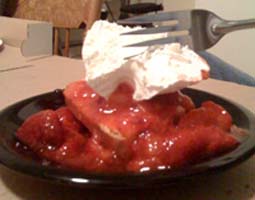
NAOmni of Not Another Omnivore grew up eating strawberry shortcake on her grandparents’ farm and once she started researching its history realized it was well over a century old. Her post explores all the different options for the dessert’s “carbohydrate” component, from biscuit to pound cake to angel food cake. But looking at NAOmni’s photo I’m wondering, does the carb even matter when you’ve got that tantalizing strawberry topping?
200 years ago ~

Inspired by a bottle of milk that needed using up, Pamela of The Cooking Ninja tries something new to her but quite old on this earth: Far Aux Pruneaux, a traditional dessert from Brittany, France with a dense flan filling flecked with sweet prunes. Dating back to the 18th century, this dish has evolved through the years from a savory buckwheat flan to the incredibly delicious sweet version we know today. (Can you tell this is one of my favorite desserts of all time? I am practically drooling on my keyboard…)
250 years ago ~

Elodie of yummyaourt gives Proust a run for his money with her charming “Once upon a time” tale of the origin of the Madeleine. She calls them “little pieces of pleasure,” and, looking at her luscious photos, I couldn’t agree more, especially when she advises flavoring them with orange blossom water or Earl Grey tea!

Karolcia of For the Body and Soul makes the Spanish version of Madeleines, called Magdalenas. Instead of a shell shape, these are made in a mini-muffin pan and use olive oil rather than butter. Karolcia is a baker after my own heart with some kitchen experimentation – she bakes half her magdalenas with baking powder and half without, to see if it really makes a difference. I feel quite willing to devour these moist and crunchy lemony treats under any experimental conditions!
350 years ago ~

Carolyn of 18thC Cuisine was the first person I thought of after I picked our theme, since everything in her fascinating blog is well over a century old. For Sugar High Friday she brings us a rich sugar cream pie flavored with almonds, baked on a piece of paper on the floor of the oven, using one of the oldest cooking techniques around!

My own contribution to our test of time was a literal test – a test of four different recipes for what is believed to be the oldest known cake or torte in the world! (Although I’m not really sure how they reckon that since there are cake- and torte-like desserts in this round-up that are clearly as old or older…) I compared the original 17th century recipe with three gluten-free varieties to see if 

 this famous Austrian treat not only held up to through the ages but could change with the times as well.
this famous Austrian treat not only held up to through the ages but could change with the times as well.
450 years ago ~

Digigirl of Don’t Forget Delicious! brings her highly applicable experience in Medieval re-creation to this event. The only trouble being, it turns out the Middle Ages weren’t exactly the golden age of dessert. But after combing through ancient cookbooks in Middle English and French, she finally turned to the internet for aid, and came up with this incredibly appetizing sweet and juicy tart featuring wine-soaked strawberries – or strawberryes as they called them back in the day!
500 years ago ~
Hyderabadi Almond-Semolina Halva
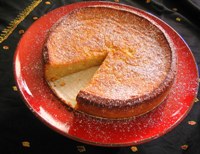
Muneeba of An Edible Symphony gives props to her heritage with a fragrant, saffron-infused dessert. Even though her beloved Cuisinart met its end trying to prepare this dish, Muneeba soldiered on valiantly and the delectable results were clearly worth the effort! The hour it ending up taking to blend the mixture by hand gives me great sympathy and respect for the Hyderabadi princesses who first enjoyed almond-semolina halva. (Or great sympathy for their cooks, rather!)
1500 years ago ~

Anna at Life’s Too Short For Mediocre Chocolate is a history buff, and puts her expertise to work sharing the history and symbolism of Hot Cross Buns. Adopted as an Easter sweet, these buns have their origins pre-Christian England where they once (and still do, for some) honored the Saxon Spring goddess Eostre. Whatever they stand for, cranberry walnut hot cross buns with cream cheese frosting sound like sweet, sweet symbolism to me!
2000 years ago ~

Even Ivy, of Kopiaste… to Greek Hospitality, isn’t sure how old the recipe is for daktyla, one of the best-known pastries of Cyprus, only that is has been passed down in her family from generation to generation. I did some research on similar pastries, however, and it seems daktyla may have been around for two thousand years! Clearly these heavenly phyllo “fingers” stuffed with almonds and orange blossom water have had the staying power needed to make it through the ages.

Sra of When My Soup Came Alive puts a new spin on a very old formula by making an ancient Indian rice pudding from couscous. The results look positively ambrosial – I think you may start a trend here, Sra! What magic can come from expediency – in this case a years-old packet of couscous that needs to be used up becomes a reworked classic that will probably get made again and again.
Back to the present day ~
Well, friends, there’s the round-up! Thank you for joining me on this excellent adventure through time and place. I truly enjoyed all your marvelous creations and I learned so much! I feel ready for my pop quiz on dessert history now…
I’ll meet you next month for another sweet, sweet Friday!





 In the first corner: the “
In the first corner: the “
 Holding down the healthy corner:
Holding down the healthy corner:  Rounding out the quartet: I looked through my Bette Hagman dessert book (Bette was the grand doyenne of gluten-free baking) to see if she had a recipe for Linzer Torte and found one for Nut Crust Supreme that seemed along similar lines. I decided to follow my friend Laurie’s Valentine’s torte recipe, the one that originally sparked my Linzer lust, but with Bette’s GF Flour Mix (1 part rice flour, 2/3 part tapioca flour, 1/3 part potato starch) in place of the wheat flour.
Rounding out the quartet: I looked through my Bette Hagman dessert book (Bette was the grand doyenne of gluten-free baking) to see if she had a recipe for Linzer Torte and found one for Nut Crust Supreme that seemed along similar lines. I decided to follow my friend Laurie’s Valentine’s torte recipe, the one that originally sparked my Linzer lust, but with Bette’s GF Flour Mix (1 part rice flour, 2/3 part tapioca flour, 1/3 part potato starch) in place of the wheat flour.


 Illustration from The New York Cook Book by Marie Martinelo, published in 1892
Illustration from The New York Cook Book by Marie Martinelo, published in 1892